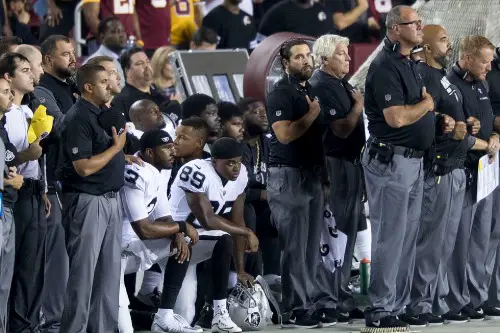1. Standing for the National Anthem at Sports Games

Americans have been standing for the national anthem at sporting events since World War I, when the tradition began as a wartime show of unity. Back then, it was rare and mostly reserved for special games, but it became standard during World War II when patriotism surged. Now, it’s so ingrained that even a preseason baseball game will pause for the anthem. Nobody really questions whether it needs to happen every time—people just keep doing it because it feels awkward not to.
The original reasoning was tied to national morale, not necessarily sports themselves. But over time, it became a symbol of respect for the flag, regardless of the occasion. Even in small-town high school gyms, everyone instinctively stands, hand over heart, without much discussion. It’s an example of how a custom becomes “normal” simply because no one wants to be the first to break it.
2. Saying “Bless You” When Someone Sneezes

This habit has deep roots in superstition, with origins in ancient Rome and later reinforced during plague outbreaks in Europe. The American version is just as reflexive, even though most people don’t think it’s actually protecting anyone’s soul or health. The phrase is so automatic that silence after a sneeze can feel almost rude. You might not even notice you’re doing it until you’re saying “bless you” to a stranger in an elevator.
The custom likely stuck in the U.S. because it’s seen as polite, even if the original fears of spirits or illness are long gone. Not saying anything could make you seem cold or inattentive. People don’t want to appear impolite in a micro-social interaction, so they keep the habit alive. It’s politeness inertia at its finest.
3. Throwing Elaborate High School Proms

Proms started as modest, chaperoned dances in the early 20th century for college students, but American high schools embraced them after World War II. Over time, they grew into over-the-top events with tux rentals, limo rides, and sometimes entire weekends planned around them. The expense and production are rarely questioned, even when students and parents grumble about the cost. Nobody wants to be the one school that says, “We’re just doing a casual potluck.”
The ritual is wrapped up in ideas about “once-in-a-lifetime” experiences. Canceling or downsizing could make a school look like it doesn’t care about tradition or student life. Even schools that try to modernize the event tend to keep the trappings like formalwear and grand entrances. The pressure comes less from necessity and more from tradition’s momentum.
4. Clapping When a Plane Lands

This one’s more common in certain parts of the U.S., especially on vacation routes to tourist-heavy destinations. The custom likely stems from a mix of relief and appreciation for pilots back when air travel was less routine. In modern times, flights are so safe that clapping isn’t necessary—but it still happens. Passengers often join in because it feels like the polite or celebratory thing to do.
It’s a classic case of social mimicry—if a few people start clapping, others will follow. Many join just to avoid seeming grumpy or ungrateful, even if they privately think it’s cheesy. The act is less about actual thanks and more about sharing a small, harmless moment of togetherness. And once that ripple starts, almost no one wants to be the one sitting there with arms crossed.
5. Singing “Happy Birthday” in a Group

The song became a birthday standard in the U.S. in the early 20th century and spread quickly through schools, churches, and family gatherings. Despite being famously awkward—no one knows where to look or what to do with their hands—it persists everywhere. The shared discomfort is just part of the ritual now. Even people who hate attention tend to accept it as inevitable.
Part of why it’s so sticky is that it’s a rare moment of group recognition in casual social life. Opting out could make you look joyless or unfriendly, so the ritual rolls on. It’s not about the melody or even the words—it’s the symbolism. Everyone knows it’s awkward, but they do it anyway because stopping would feel more awkward.
6. Bringing a Host Gift to Dinner Parties

In the U.S., showing up empty-handed to someone’s home for a meal can feel almost taboo. The custom grew from older European traditions of offering something to the host, but Americans solidified it in the mid-20th century as part of suburban hospitality culture. Even if the host insists nothing is needed, most people still bring wine, flowers, or dessert. It’s as much about avoiding social guilt as it is about generosity.
This isn’t written into any etiquette law, but skipping it can leave you worrying you’ve committed a faux pas. The practice endures because it’s a low-effort way to show thoughtfulness. Even if the gift goes unused, it communicates a shared understanding of courtesy. And because no one wants to be seen as the lone guest without something in hand, the cycle continues.
7. Lining Up for Black Friday Sales at Dawn

Black Friday doorbusters took off in the late 20th century as retailers pushed post-Thanksgiving shopping frenzies. Early-morning lines became part of the marketing spectacle, and people began to treat it like a sport. Even with the rise of online deals, many still camp out in the cold for that “tradition” factor. It’s less about the actual savings now and more about the story.
The ritual thrives because it’s a shared cultural event, even for those who don’t buy much. Skipping it might feel like missing out on a seasonal experience. For some, the line itself becomes part of the fun, even if the payoff isn’t huge. And so, year after year, the lines form before sunrise.
8. Pledging Allegiance in Schools

The daily recitation of the Pledge of Allegiance became widespread in American classrooms in the early 20th century, especially during times of national stress. While some states now allow students to opt out, it’s still a standard morning routine in many places. Teachers and administrators keep it because it’s “just what you do” to start the day. Most kids recite it without thinking much about its origins.
The original intent was to promote unity and patriotism, particularly among immigrant populations. Now, the continuation often has more to do with inertia than conscious choice. Schools that remove it risk controversy or backlash from parents. So it stays in place, largely unexamined, because no one wants to ignite that fight.
9. Sending Holiday Cards by Mail

Americans began exchanging Christmas cards in the mid-1800s, copying a British tradition. The custom became a booming industry by the 20th century, with printed family photo cards adding a personal touch. Even in the digital age, many people still send them, partly out of habit and partly to avoid appearing impersonal. They can be as much about signaling connection as they are about holiday cheer.
There’s a quiet social pressure here: if someone sends you a card, you feel you should send one back. For families, the yearly card doubles as a public update and proof of togetherness. Skipping it might raise eyebrows or questions. And so the annual trip to the post office continues.
10. Wearing Caps and Gowns at Graduation

The tradition comes from medieval European universities, but American schools embraced it in the late 19th and early 20th centuries. Now, even kindergarten “graduations” sometimes have miniature versions. Few people question why everyone must dress in heavy robes and awkward mortarboards for a ceremony. The look has become shorthand for academic achievement.
Schools keep it going because it makes for memorable photos and unites all graduates visually. Not participating would make you stand out in the worst way. Even though the garments aren’t especially practical or comfortable, they’re a rite of passage. And so, year after year, everyone zips up the same regalia.
11. Doing the “Wave” at Sports Events

The wave started in American stadiums in the early 1980s and quickly became a crowd favorite. It’s completely optional, but when it starts sweeping around, participation feels almost compulsory. Not joining can make you feel like you’re missing the point of the shared experience. Even people who think it’s silly often find themselves throwing their arms up.
It persists because it gives large groups of strangers a sense of instant unity. There’s no practical reason to keep it alive beyond collective fun. But it’s harmless, and no one wants to be the buzzkill in a roaring stadium. So the ripple keeps circling, game after game.
12. Standing in a Buffet Line Instead of Grabbing Food at Random

American buffet etiquette follows an unspoken “start at one end and move in order” rule. It’s not actually necessary—you could technically just skip to the dessert if you wanted—but almost nobody does. The line itself becomes part of the structure, even if it slows things down. People fear cutting in might seem rude or chaotic.
The system probably endures because it avoids social friction, not because it’s the most efficient way to get food. Everyone knows where they stand, literally, in the process. Even at casual gatherings, the single-file approach feels natural. And once everyone else is doing it, deviating seems like a breach of unwritten law.
This post 12 Social Customs That Only Exist Because No One Wants to Be the First to Stop Doing Them was first published on American Charm.


